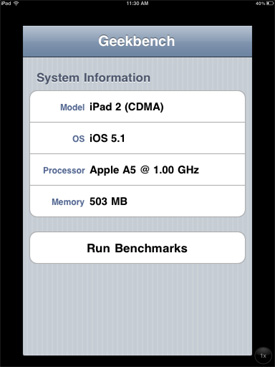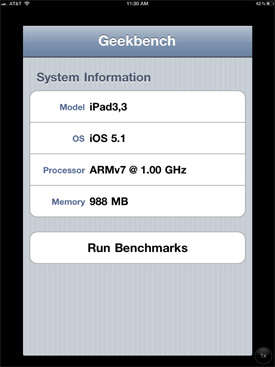The Apple iPad Review (2012)
by Vivek Gowri & Anand Lal Shimpi on March 28, 2012 3:14 PM ESTThe Display
The most visible improvement of the new iPad is naturally its Retina Display. Originally introduced with the iPhone 4, the concept of an Apple Retina Display was created to refer to a display where the pixel density was high enough that the human eye, at a standard viewing distance, could not resolve or identify individual pixels.
Unlike traditional OSes, iOS doesn't support a laundry list of display resolutions. The iPhone was introduced at 480 x 320 (3:2 aspect ratio), while the iPad came to be at 1024 x 768 (4:3 aspect ratio). Rather than require iPhone applications be redesigned for a higher resolution iPhone, Apple simply doubled both the vertical and horizontal resolution for the iPhone 4—maintaining the same aspect ratio as the previous models, and only requiring higher quality assets, not a redesigned UI, to take advantage of the new display.
The iPad on the other hand always required a redesigned UI to make the most of the iPad's larger display and higher resolution. With a different aspect ratio, simply scaling up an iPhone app wouldn't work (although to enable backwards compatibility Apple did allow you to do just that). Admittedly Apple wouldn't want to allow such easy portability between iPhone and iPad apps as it wanted the extra effort to improve the quality of tablet apps.
The new iPad does what the iPhone 4 did and doubles both horizontal and vertical resolution: from 1024 x 768 to 2048 x 1536. All iPad applications work by default as developers don't directly address pixels but rather coordinates on the screen. Existing apps take up the full screen, and if higher resolution images are present they are used as they avoid the interpolation associated with scaling up an image designed for the original iPad resolution. For example, below we have a makeshift iOS icon in three different forms—10x7 native (72x72), upscaled to a 2x version using bicubic interpolation (144x144), and a 2x resolution version (144x144):
|
72x72
|
144x144 (Upscaled)
|
144x144 (Native)
|
|
|
|
|
The upscaled form looks good, but the 2x resolution version looks better.
More traditional OSes have always given you additional desktop real estate with increased resolutions. iOS simply gives you a better looking desktop. This distinction is arguably one of the reasons why the new iPad's display can be so polarizing. As consumers of high-end displays we're used to higher resolution going hand in hand with a larger panel size. Alternatively, we're used to a higher resolution enabling us to see more on a screen at one time. In the case of the new iPad, the higher resolution just makes things look sharper. It's a ton of work for an admittedly more understated impact, but it's the type of thing that simply had to be done.
Retina Display Enabled Apps
Apple has created such a healthy marketplace with the app store that developers are eager to quickly deliver apps with updated graphics for the new iPad. Sure enough, by the day of launch we saw several high profile applications with higher resolution assets for the new iPad. The motivation to have Retina Display support is huge as Apple is actively promoting those apps that have been updated for the new iPad via the app store:

These updated apps now come with larger image assets, which can increase the total app size. Not all apps will grow in size (e.g. Infinity Blade 2 simply renders at a higher resolution vs. using tons of new content, not to mention that textures are already heavily compressed) but some have/will. The retina burden unfortunately impacts all iPads as there's only a single app package delivered upon download. Even if you don't use them, the higher resolution retina graphics are there.
Note that iPhone apps will now load their Retina assets (designed for 640 x 960) rather than their normal assets (designed for 320 x 480) on the new iPad, resulting in a significant improvement in image quality there as well:
Games are a special exception to the 2x asset scaling of the new iPad. Applications that simply have their UI accelerated by the A5X's GPU do fairly well at the iPad's native resolution. 3D games are another story however.
If all you're doing is determining the color of a single pixel on the screen, not impacted by lights in 3D space or other transparent surfaces above the surface, it's a relatively simple and painless process. For the majority of what you're looking at in iOS, this is simply the procedure. The app instructs the drawing APIs to place a red pixel at a set of coordinates and that's what happens. In a 3D game however, arriving at the color value of that pixel can require quite a bit of math, and quite a bit of memory bandwidth.
Game developers have a few options on the new iPad. One option is to not update a game, running it at 1024 x 768 and rely on the iPad's scaler to upscale the image to 2048 x 1536. The game will take up the full screen, run faster than on the iPad 2, but it won't necessarily look any better. Low resolution content upscaled to a higher resolution display still maintains much of the aliasing you'd see at a lower resolution.
Another option is to render all scenes at the new iPad's resolution: 2048 x 1536. With four times the number of pixels to fill and only 2x the compute and memory bandwidth compared to the iPad 2, this will only work for fairly lightweight content. Not to say that it's impossible—even GLBenchmark's Egypt test, in its current form, actually runs very well at the new iPad's native resolution. Many stressful 3D games won't fall into this category however.
The third, and more popular option is for a game developer to render all frames offscreen at an intermediate resolution between 1024 x 768 and 2048 x 1536, then scale up to the panel's native res. So long as the developer maintains aspect ratio, it'll be possible to use this approach and get a good balance of higher resolution and performance.

Infinity Blade 2 for the new iPad Renders at roughly 1.4x the iPad 2's resolution, then upscales to fill the screen
Infinity Blade 2, for example, renders offscreen at roughly 1.4x the resolution of the iPad 2 before scaling up to 2048 x 1536 for final display. The result is a sharper image than what you'd get on an iPad 2, without sacrificing performance.
Game developers may choose to increase the level of anti-aliasing instead of or in combination with an increase in resolution. As we'll discuss shortly, Apple's A5X does come equipped with more GPU execution resources and dedicated memory bandwidth for graphics that would allow for an increase in quality without a corresponding decrease in frame rate.



















234 Comments
View All Comments
PeteH - Tuesday, April 3, 2012 - link
I have to be honest, after reading through that link I didn't see anything that even implied working conditions had anything to do with the suicides of the factory workers. The only suicide for which there was any real information provided was that of the worker who killed himself after losing the iPhone prototype, and in that case the victim wasn't a factory worker, but someone in logistics.Did working conditions have anything to do with the factory worker suicides? Maybe, maybe not. There doesn't appear to be evidence either way.
mr_ripley - Wednesday, April 4, 2012 - link
I posted the Wikipedia link for all the links in the reference section.Here's a more direct report: http://sacom.hk/wp-content/uploads/2010/11/report-...
And a companion video: http://vimeo.com/17558439
The video includes an interview of a survivor who is now paralyzed waist down.
You can choose to patiently read and watch this report or just turn a blind eye like a lot of people do.
PeteH - Thursday, April 5, 2012 - link
I did read the report. It details unbelievably miserable working conditions in the factories, which I don't think anyone is disputing, and concludes that the way to change those conditions is to pressure the electronics companies making the bulk of the profits. None of the above comments dispute any of this. However it does not link working conditions to suicides among factory workers.And yet you continue to insist that there is a link, with no evidence to back it up. You make statements like, "over a hundred of them have committed suicide over the working conditions," "...scores of people killing themselves citing poor working conditions," and "there is no disputing the fact that these deaths are related to working conditions," but you provide only conjecture to back it up, no proof. When you do this people start dismissing everything you say out of hand, even the things that are accurate. And worse than that, you run the risk that other people arguing for better working conditions will be tarred with the same brush. Look at what happened to Mike Daisy.
Again, I'm not saying working conditions didn't contribute to the suicides, I'm saying there is no evidence one way or the other. Until you have evidence (in the form of suicide notes, higher suicide rates among factory workers, etc.) please stop. You may actually be hurting the very movement you're trying to help.
mr_ripley - Thursday, April 5, 2012 - link
Well, I'm sorry if it is inconvenient for you that these individuals have not said it in so many words. Should we expect them to?... Hey, by the way, I know you're going to kill yourself but why don't your write down an explanation first so we can conclusivly say what the reasons are. And even though you are under a lot of stress right now and are clearly not thinking straight SPELL it our for me please...Evidence can come in different forms. Not all of it is directly incriminating, in which case the attention turns to the circumstances. So if these reports don't establish a reasonbly clear coorelation to you, then I am sorry but I disagree.
You can nitpick on specific words in my comments and quible about words such as evidence. But what are you accomplishing here? Are you justifying your own guilt of purchasing a device manufactured here? Are you an Apple or Foxconn mouthpeice? Do they pay your for spreading lies like Foxconn factories are actually a good place to work (which has been said in the previous comments)? Really, it is people like you need to STOP.
I'm not going to stop saying what I believe is right!! And unlike Mike Daisy I have not fabricated any evidence. At the most, you can complain that I have drawn incorrect conclusions and I am saying the same about you.
PeteH - Thursday, April 5, 2012 - link
It's inconvenient for me that you are lying. You're the one saying that there are, "...scores of people killing themselves citing poor working conditions," not me. Either show me a case where those people who killed themselves cited poor working conditions as the reason, or cease claiming it is fact. You do damage to the movement that's trying to improve things.People hear the news reports about Mike Daisy lying to Ira Glass and what they take away is not the specific lies (claiming to witness things had actually happened but that he had only read about), it's that he's a liar and the story wasn't true. They dismiss the whole issue of poor working conditions out of hand. That's what you risk when you lie to get people to listen.
mr_ripley - Thursday, April 5, 2012 - link
Go ahead, nitpick on specific phrases and completely lose the meaning. But the problem is easily corrected. One can argue that citing something does not have to be done on paper as you would in a professional article. To me the workers "cite" the existence of a problem through their actions as words have failed them.Still if you want me to rephrase I'll say "scores of people killing themselves in midst of poor working conditions.." Can you prove that this statement is inaccurate??
And while you ask me for evidence have you ever bothered to see if you can find evidence that these deaths are not related to working conditions. Prove it to me and I'll take back everything I said.
PeteH - Thursday, April 5, 2012 - link
I think you missed the places above where I stated, "I'm not saying working conditions didn't contribute to the suicides, I'm saying there is no evidence one way or the other." That was my whole point. And I did explicitly state that there's no disputing the poor working conditions. So no, I have no problem with your revised statement.However, I don't think what I did was nitpicking at all. Nitpicking would be pointing out that a score is 20, so scores would imply at least 40, and I've only seen documentation of 17 suicides (I haven't seen numbers pre-2010). But that's not what I did.
shompa - Friday, March 30, 2012 - link
Manufacturing employees?Look at the world! There are about 20 countries in the world that are democratic and have great living standards. Its just 100 years ago since these countries had child workers and harsh condition.
BTW. My county is on the "top countries" in the world. Still we have the largest suicide rate in our population in the world. Why are you not fighting against the Swedish government that drives thousands to kill them self each year? We live like slaves here with 80% taxes.
BTW. Do you care if other companies use HonHai/FoxConn or is it just Apple? Are you writing the same thing about Dell/HP and all other companies that use FoxConn?
What have you done?
Have you donated money to a chinese worker? Or is Trolling the only thing you manage to do?
grave00 - Friday, March 30, 2012 - link
I was curious about this statement. Could you elaborate. What inconsistency is there?"On the iPhone Apple has been entirely too lax about maintaining consistency between suppliers. If it wants to be taken seriously in this space Apple needs to ensure a consistent experience across all of its component vendors."
loboracing - Friday, March 30, 2012 - link
I remember an ad that touted something new to "see and touch". The retina screen is the "see" part but what about the "touch"? Was that just a gimmick meaning you could touch the screen, or is there some sort of different feel to the screen?